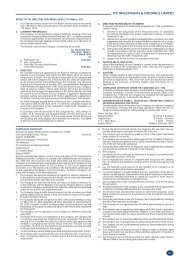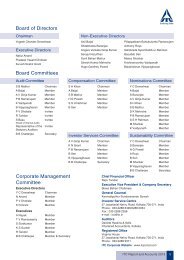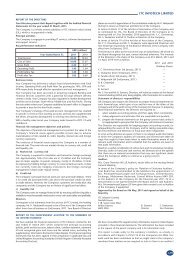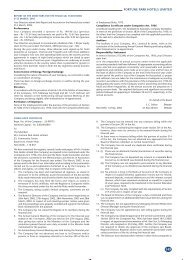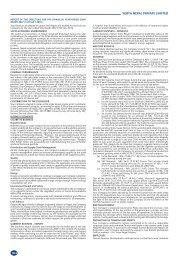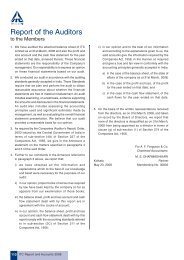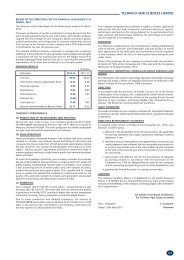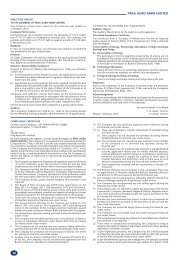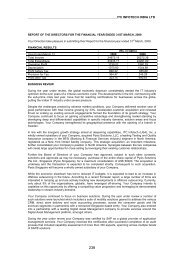SUBSIDIARY COMPANIES - ITC Ltd
SUBSIDIARY COMPANIES - ITC Ltd
SUBSIDIARY COMPANIES - ITC Ltd
You also want an ePaper? Increase the reach of your titles
YUMPU automatically turns print PDFs into web optimized ePapers that Google loves.
NOTES TO THE FINANCIAL STATEMENTS<br />
March 31, 2012 and 2011<br />
NOTE A - BUSINESS BACKGROUND AND PRINCIPAL TRANSACTIONS<br />
WITH AFFILIATES<br />
<strong>ITC</strong> Infotech (USA), Inc. (the “Company”), a New Jersey corporation, is<br />
principally engaged in the information technology services business. Majority<br />
of its customers are commercial entities and software developers throughout<br />
the United States of America. The work is usually performed under contracts<br />
which specify fixed hourly rates (which depend upon the skill level of the<br />
employee staffed at the customer’s location) and which vary in length, but<br />
are typically less than two years in duration. The Company generates revenue<br />
through specific projects, whereby the Company and its overseas affiliates<br />
undertake the responsibility to deliver specific software solutions (”Project<br />
Business”) on a contractual basis. Substantially all of these contracts for<br />
Project Business were co-sourced, in terms of the marketing agreement with<br />
its affiliates (see Note D), or fulfilled with resources drawn from affiliates, on<br />
a contractual basis, to supplement the Company’s resources. The Company<br />
either receives fees from affiliates for client account management in respect<br />
of work contracted between <strong>ITC</strong> Infotech India <strong>Ltd</strong>. or <strong>ITC</strong> Infotech <strong>Ltd</strong>. (UK)<br />
with clients in the United States, or incurs subcontract costs for technical<br />
services provided by affiliates to support customer contracts entered into by<br />
the Company.<br />
The Company is a wholly owned subsidiary of <strong>ITC</strong> Infotech India <strong>Ltd</strong>. (”Infotech<br />
India”), an Indian company. There are 185,000 common shares authorised<br />
of which 182,000 have been issued, and are outstanding, to Infotech India.<br />
<strong>ITC</strong> Infotech <strong>Ltd</strong>. (”Infotech UK”) is also a wholly owned subsidiary of<br />
<strong>ITC</strong> Infotech India <strong>Ltd</strong>.<br />
The Company acquired 100% of the membership interests of Pyxis Solutions,<br />
LLC (”Pyxis”) on August 11, 2008. Pyxis was formed as a New York State<br />
limited liability company in 2000. One of the founder members of Pyxis also<br />
owns a majority interest in an entity performing similar services in Singapore<br />
(”Pyxis Singapore”). Pyxis is principally engaged in the information technology<br />
services business offering Quality Assurance (QA) solutions and testing services.<br />
Its customers are commercial entities throughout the United States of America.<br />
NOTE B - SUMMARY OF SIGNIFICANT ACCOUNTING POLICIES<br />
1) Basis of Presentation<br />
As required by the parent company the financial statements of the Company<br />
are not prepared in accordance with accounting principles generally accepted<br />
in the United States as this presentation does not consolidate the results of<br />
its wholly owned subsidiary Pyxis. So accordingly, these financial statements<br />
do not purport to follow US GAAP. Furthermore, as permitted by accounting<br />
principles generally accepted in the United States, the impact of the acquisition<br />
of Pyxis was not pushed-down to Pyxis. Accordingly, the intangible assets<br />
presented herein relate to the excess purchase price over the fair value of<br />
current assets and liabilities. These financial statements are presented in U.S.<br />
dollars. However, as required by the parent company, the Indian Rupee<br />
equivalent figures, arrived at by applying the average interbank exchange<br />
rate of US$1 = 48.05 (2011 US$1 = Rs. 44.60) as provided by the parent<br />
company, have been included solely for informational purposes and is not<br />
in conformance with the provisions of FASB ASC 830-30 - Foreign Currency<br />
Matters - Translation of Financial Statements and U.S. GAAP.<br />
2) Recognition of Revenue<br />
Service Revenue<br />
Service revenues are based upon hours worked by Company employees on<br />
customer assignments and are recognized when the work is performed.<br />
Revenue is determined by multiplying the hours worked by the contractual<br />
billing rates. Substantially all customers are invoiced weekly, biweekly, or<br />
monthly.<br />
Project Revenue<br />
Revenues on the project business are recognized as earned, typically in the<br />
month the service is performed. Costs associated with the use of subcontractors<br />
to fulfill such project business are recognized in the same period.<br />
In accordance with Accounting Standards Codification Topic (”ASC”) 605,<br />
“Revenue Recognition”, the Company recognizes revenues on delivery when<br />
a non-cancellable agreement has been executed, fees are fixed and<br />
determinable and collection is considered probable unless there is significant<br />
uncertainty about customer acceptance, in which case revenues are recognised<br />
upon such acceptance. Losses on contracts are recognised when determinable.<br />
3) Account Management Fees<br />
Fees for client account management in respect of work contracted by Infotech<br />
India and Infotech UK with clients in the United States are billed monthly at<br />
a predetermined rate applied on the amount billed by Infotech India and<br />
Infotech UK, to its clients.<br />
140<br />
<strong>ITC</strong> INFOTECH (USA), INC.<br />
4) Cash and Cash Equivalents<br />
For purposes of reporting cash flows, the Company considers all cash accounts<br />
which are not subject to withdrawal restrictions or penalties, and certificates<br />
of deposit with maturities of ninety days or less, when purchased, to be cash<br />
or cash equivalents.<br />
5) Accounts Receivable<br />
Credit is extended based on evaluation of a customer’s financial condition<br />
and, generally, collateral is not required. Accounts receivable are generally<br />
due within 30 to 60 days and are stated at amounts due from customers net<br />
of an allowance for doubtful accounts. Accounts outstanding longer than<br />
the contractual payment terms are considered past due. The Company<br />
creates an allowance for accounts receivable based on historical experience<br />
and management’s evaluation of outstanding accounts receivable. Accounts<br />
are written off when they are deemed uncollectible.<br />
6) Equipment, Software, Furniture and Fixtures and Leasehold<br />
Improvements<br />
Equipment, purchased or internally developed software, furniture and fixtures<br />
and leasehold improvements are stated at cost. Depreciation is provided<br />
under the straight line method based upon the estimated useful lives of the<br />
assets, with such lives ranging up to five years.<br />
7) Income Taxes<br />
The Company accounts for income taxes pursuant to ASC 740, “Income<br />
Taxes” (”ASC 740”). ASC 740 requires recognition of deferred tax assets and<br />
liabilities for the expected future tax consequences of events that have been<br />
included in the financial statements or tax returns. Under this method,<br />
deferred tax assets and liabilities are determined based on the differences<br />
between the financial reporting and tax bases of assets and liabilities using<br />
enacted tax rates in effect for the year in which the differences are expected<br />
to reverse. Future tax benefits, such as net operating loss carry forwards, are<br />
recognised to the extent that realisation of these benefits is considered to<br />
be more likely than not. If the future realisation of such benefits is uncertain,<br />
then a valuation allowance is provided.<br />
The Company provides for income tax in accordance with the Financial<br />
Accounting Standards Board (”FASB”) issued ASC 740-10, “Income Taxes”<br />
(”ASC 740-10”). ASC 740-10 provides recognition criteria and a related<br />
measurement model for uncertain tax positions taken or expected to be<br />
taken in income tax returns. ASC 740-10 requires that a position taken or<br />
expected to be taken in a tax return be recognised in the financial statements<br />
when it is more likely than not that the position would be sustained upon<br />
examination by tax authorities. Tax positions that meet the more likely than<br />
not threshold are then measured using a probability weighted approach<br />
recognising the largest amount of tax benefit that is greater than 50% likely<br />
of being realised upon ultimate settlement. There were no significant matters<br />
determined to be unrecognised tax benefits taken or expected to be taken<br />
in a tax return that have been recorded in the Company’s financial statements<br />
for the year ended March 31, 2012. The income tax returns of the Company<br />
are subject to examination by the IRS and other taxing authorities, generally<br />
for three years after they are filed.<br />
8) Use of Estimates<br />
In preparing financial statements in conformity with accounting principles<br />
generally accepted in the United States of America, management is required<br />
to make estimates and assumptions that affect the reported amounts of<br />
assets and liabilities and disclosure of contingent assets and liabilities at the<br />
date of the financial statements, as well as the reported amounts of revenues<br />
and expenses during the reporting period. Although actual results could<br />
differ from those estimates, in the opinion of management such estimates<br />
would not materially affect the financial statements.<br />
9) Reclassifications<br />
Certain prior year amounts have been reclassified to conform to the current<br />
year presentation.<br />
10) Advertising Costs<br />
Advertising costs are expensed as incurred.<br />
11) Long-Lived Assets<br />
The Company follows ASC 360, “Property, Plant and Equipment”. Accordingly,<br />
whenever events or circumstances indicate that the carrying amount of an<br />
asset may not be recoverable, the Company assesses the recoverability of<br />
the asset. No impairment charge has been recorded in fiscal years ended<br />
March 31, 2012 or 2011.




